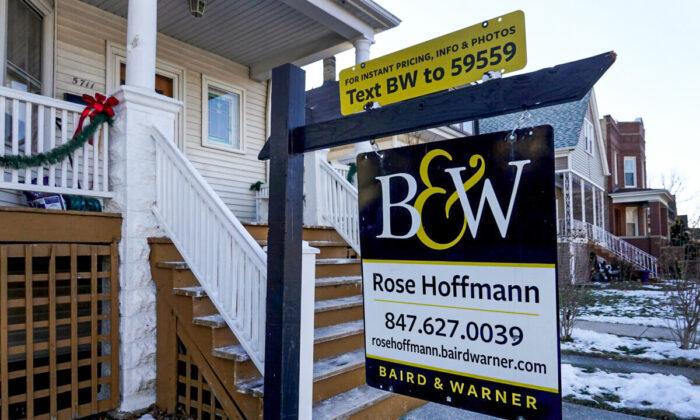U.S. home sales fell in February to a near-record low, as shortages of houses and double-digit price growth continue to push first-time buyers out of the market.
Contracts to buy resold homes, which account for the bulk of U.S. home sales, have fallen for three straight months in all four regions of the United States, according to a March 18 National Association of Realtors (NAR) report.
The number of homes for sale at the end of February totaled just 870,000.
Sales have declined by 2.4 percent on a year-over-year basis since February 2021, as the median home price jumped by 15 percent in the same time period to $357,300.
A quarter of all homes sold in February were purchased with cash, down from 27 percent in January but up from 22 percent of sales in February 2021, according to the NAR report. Real estate investors or second-home buyers accounted for 19 percent of transactions in February, up from 17 percent in February 2021.
First-time buyers made up only 29 percent of all homes sold.
The low number of available properties in February amounts to a 1.7-month supply, according to the current sales pace, down from a two-month supply available one year prior, reported the report.
The inventory of unsold homes was down by 15.5 percent from February year-over-year.
A recent survey from the National Association of Home Builders reported that developer confidence had dropped to a six-month low in March because of supply constraints and inflation.
Building materials still remain in short supply as builders also struggle with high prices for key materials such as lumber.
Mortgage rates rose to 4.16 percent in the week ending March 18, exceeding 4 percent for the first time in nearly three years. Sales are likely to slow down in 2022, but that will do little to curb house price inflation.
The rates were expected to surge in February, with the 30-year fixed rate approaching a three-year high, according to data from Freddie Mac.
On March 18, 2021, the average mortgage rate stood at 3.09 percent.
The increasing costs of financing a home are compounded by rising inflation, which is running at its highest level since the 1980s.
“As a buyer, it’s still a struggle to get into the market with the lack of inventory,” said Lawrence Yun, NAR’s chief economist. “First-time buyers are struggling to try to get into the market.”
Analysts say they’re still optimistic about the housing market for 2022, as younger millennials who have entered the workforce look to become homeowners. But the short supply of housing and higher interest rates will restrict options for first-time buyers, who accounted for only 29 percent of sales in February.
Yun estimated that the rise in rates and escalating prices have pushed up monthly home payments by 28 percent from what they were a year ago.
The low mortgage rates in 2021 gave home buyers additional buying power as prices soared, but home loan rates are expected to rise in 2022 as the Federal Reserve hikes up interest rates to fight inflation.
At its March 16 meeting, the Federal Open Market Committee voted to raise the Fed’s benchmark interest rate by 25 basis points in order to push borrowing costs to restrictive levels by 2023, with up to six additional rate hikes possible in 2022.
A report from the FOMC showed a rebound in U.S. economic activity in February, suggesting that further economic growth will continue despite tighter monetary policy and the uncertainty caused by the conflict in Ukraine.





